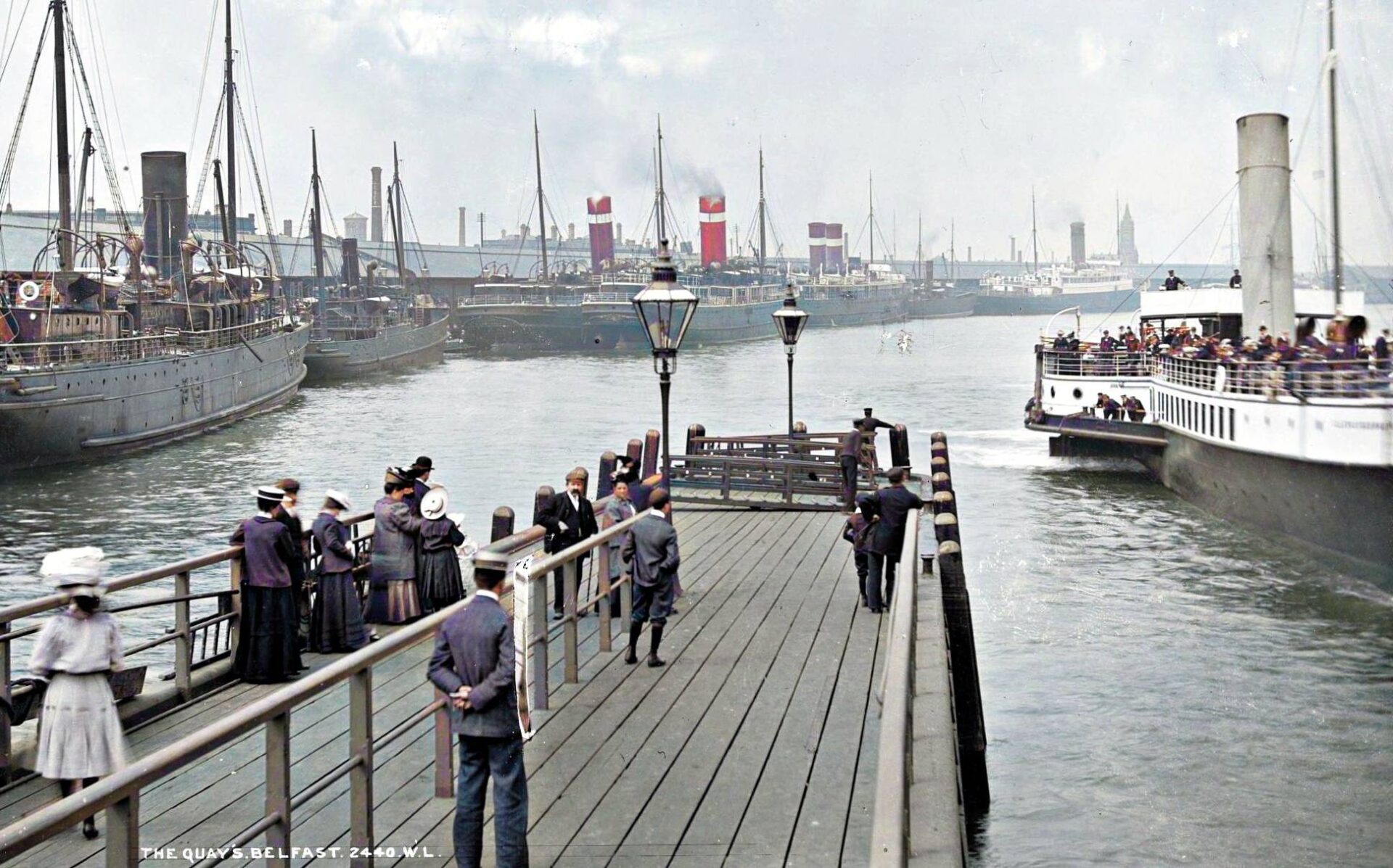Unraveling the Complex History of Irish Immigration
The story of Irish immigration is one that has shaped not only the Emerald Isle itself but also the many countries where its people have settled. From the earliest settlers in the New World to the more recent waves of emigrants seeking new opportunities in countries like the United States, Canada, Australia, and beyond, the Irish have left an indelible mark on the world.
In this article, we will delve into the fascinating history of Irish immigration, exploring the key ports of departure and arrival that have played a crucial role in the movement of millions of Irish immigrants. This information is invaluable for genealogy enthusiasts and researchers alike, as it provides a crucial starting point for tracing the journeys of Irish ancestors.
We will also provide an overview of the historical context that drove many Irish people to leave their homeland and the challenges they faced upon arrival in their new countries. By understanding the significance of these ports, you will gain a deeper appreciation of the rich tapestry of Irish immigration history and the lasting impact it has had on countless families and communities.
Key Ports of Departure in Ireland: From the Emerald Isle to New Horizons
Dublin Port: The Heart of Irish Emigration
As the capital city and largest port in Ireland, Dublin has long been a major point of departure for Irish immigrants. With its central location on the east coast, Dublin Port has offered easy access to Britain and other European destinations as well as the wider world. During the
19th and early 20th centuries, steamships bound for North America and Australia regularly departed from Dublin, carrying countless Irish men, women, and children seeking a better life abroad.
In the decades following the Great Famine, Dublin Port saw a steady increase in emigration numbers as people from all over Ireland boarded ships to escape the dire economic conditions at home. Today, Dublin Port remains an important symbol of Irish emigration, and its records offer valuable information for genealogists researching their Irish heritage.
Cobh (Queenstown): A Major Transatlantic Gateway
Located on the southern coast of Ireland, Cobh (formerly known as Queenstown) served as an essential port for Irish immigrants during the peak years of the 19th and early 20th centuries. As the last port of call for many transatlantic ships leaving Europe, Cobh was a crucial departure point for millions of Irish people bound for the United States, Canada, and other destinations across the Atlantic Ocean.
Notably, the ill-fated RMS Titanic made its final stop in Cobh before embarking on its tragic maiden voyage in 1912. Today, the town’s maritime history is preserved in the Cobh Heritage Centre, which houses an extensive collection of emigration records and artifacts, making it an essential resource for those researching their Irish family history.
Belfast: The Industrial Powerhouse
As the largest city in Northern Ireland, Belfast has played a significant role in Irish immigration history. With its thriving shipbuilding industry, Belfast’s ports saw a substantial number of Irish workers emigrating to find work in other shipyards and industrial centers around the world.
Moreover, Belfast was a major departure point for Scottish and English emigrants during the 19th century, many of whom traveled to the New World via Irish ports. As a result, Belfast’s immigration records offer valuable insights not only for those tracing their Irish roots but also for researchers interested in the broader story of British emigration.
Derry (Londonderry): A City of Conflict and Hope
Situated on the banks of the River Foyle in Northern Ireland, Derry (also known as Londonderry) served as an essential emigration port for those living in the northwestern region of Ireland. The city’s strategic location made it a crucial gateway to North America, with thousands of Irish emigrants departing its shores during the peak of the 19th-century emigration.
Derry’s rich and often tumultuous history, marked by religious and political conflict, also played a role in shaping the emigration patterns of its residents. Researchers delving into their Irish ancestry may find valuable information in the city’s immigration records, which offer a glimpse into the lives of those who left Derry in search of new beginnings abroad.
Galway: A Western Seafaring Hub
Located on the rugged west coast of Ireland, Galway has a long maritime history, making it a key port of departure for many Irish emigrants during the 19th century. As the largest city in western Ireland, Galway was a natural point of embarkation for those leaving the region, with ships regularly setting sail for North America, Australia, and other destinations around the world.
Galway’s port also played a significant role in the transportation of Irish convicts to Australia during the 19th century, a chapter of Irish emigration history often overlooked. Records from Galway’s port can provide essential information for those researching the stories of their Irish ancestors who departed from this iconic western gateway.
Limerick: The Shannon River’s Gateway to the World
Limerick, situated at the mouth of the River Shannon, has long been an important hub of trade and commerce in Ireland. As a major port on the west coast, Limerick served as a vital departure point for Irish emigrants during the 19th and early 20th centuries. With its proximity to the fertile farmlands of the region, Limerick saw many rural Irish families embark on their journey to new lands, primarily to the United States and Canada.
Today, the city’s emigration records, housed in local archives and museums, provide valuable resources for those tracing their Irish roots. By delving into these records, researchers can uncover the stories of countless Irish families who set sail from Limerick in search of a better life abroad.
Key Ports of Arrival: The First Steps in a New World
New York City: The Gateway to America
As one of the busiest and most iconic ports in the United States, New York City has long been a primary destination for Irish immigrants. From the early 19th century onwards, millions of Irish men, women, and children arrived in New York City, seeking new opportunities in the bustling metropolis.
The famous Castle Garden, and later, Ellis Island, served as the primary immigrant processing centers for the city. Today, the extensive records held at the Ellis Island National Museum of Immigration offer a treasure trove of information for those researching their Irish family history.
Boston: A Home Away from Home
With its strong historical connections to Ireland, Boston has been a major destination for Irish immigrants since the early 19th century. Known for its Irish-American community and heritage, Boston provided a familiar and welcoming environment for the many Irish men, women, and children who settled in the city.
Today, Boston’s immigration records, housed in various archives and museums throughout the city, offer valuable insights into the lives of Irish immigrants who made the city their home. These records provide crucial information for genealogists and researchers seeking to piece together their Irish family history.
Philadelphia: The City of Brotherly Love
As one of the oldest and most significant cities in the United States, Philadelphia has played a crucial role in the history of Irish immigration. The city’s thriving industries, particularly in textiles and manufacturing, attracted many Irish immigrants in search of employment during the 19th and early 20th centuries.
Philadelphia’s immigration records, held at the city’s archives and historical societies, provide a wealth of information for those researching their Irish roots. By examining these records, genealogists can learn about the lives of their Irish ancestors who arrived in the City of Brotherly Love.
New Orleans: The Crescent City Connection
As a major port on the Gulf of Mexico, New Orleans has been a key destination for Irish immigrants since the early 19th century. The city’s unique culture, a blend of French, Spanish, and African influences, provided an exotic backdrop for the many Irish men and women who settled in the region.
New Orleans’ immigration records, housed in local archives and museums, offer valuable insights into the lives of Irish immigrants who arrived in the Crescent City. By exploring these records, researchers can gain a deeper understanding of the unique experiences of their Irish ancestors in this vibrant Southern city.
Halifax: Canada’s Atlantic Gateway
As the largest city in Atlantic Canada, Halifax has long been a crucial port of entry for Irish immigrants. Its strategic location made it a natural destination for those traveling across the Atlantic, particularly during the peak years of the 19th-century emigration.
Today, the city’s immigration records, held at the Canadian Museum of Immigration at Pier 21, offer a wealth of information for those researching their Irish roots. By examining these records, genealogists can uncover the stories of countless Irish families who arrived in Halifax in search of a new life in the New World.
Saint John: The Irish Bastion of New Brunswick
Located on the Bay of Fundy in the Canadian province of New Brunswick, Saint John has been a significant destination for Irish immigrants since the early 19th century. The city’s deep-water harbor and thriving timber industry made it an attractive option for Irish settlers seeking new opportunities in North America.
The Great Famine of the 1840s saw a massive influx of Irish immigrants to Saint John, and the city’s population swelled with newcomers. Today, the city’s immigration records, housed in local archives and museums, provide invaluable information for those researching their Irish ancestry and the lives of those who settled in this important Canadian port.
Melbourne and Sydney: Down Under Destinations
As key destinations in the Australian colonies during the 19th century, Melbourne and Sydney attracted thousands of Irish immigrants seeking new lives in the Southern Hemisphere. Many Irish men and women were drawn to the Australian goldfields, while others sought opportunities in the rapidly growing urban centers.
Both cities’ immigration records, held in state archives and museums, offer valuable insights into the lives of Irish immigrants who arrived in Australia during the 19th and early 20th centuries. By examining these records, genealogists and researchers can piece together the stories of their Irish ancestors who made the long journey to a new life Down Under.
The Historical Context of Irish Immigration: Why Did They Leave?
Economic Factors: Poverty and Land Struggles
Throughout the 19th and early 20th centuries, Ireland’s economic landscape was marked by widespread poverty and land struggles. The majority of the population lived in rural areas, and land ownership was concentrated in the hands of a few wealthy landlords. Many Irish families lived in dire conditions, working as tenant farmers or laborers, and struggling to make ends meet.
These harsh economic realities drove many Irish people to leave their homeland in search of better opportunities abroad. For many, emigration was seen as the only viable option to escape the cycle of poverty and provide a brighter future for their families.
The Great Famine: A Turning Point in Irish History
The Great Famine (1845-1849) was a pivotal event in Irish history, resulting in the deaths of approximately one million people and the emigration of a further one million. The failure of the potato crop, which was the primary food source for the majority of the population, led to widespread hunger, disease, and suffering.
The Famine intensified the already-existing push factors for emigration, as desperate Irish people fled the devastation in search of refuge and sustenance. The impact of the Great Famine on Irish emigration patterns cannot be overstated, and its legacy is still felt in the Irish diaspora today.
Political Factors: Seeking Freedom and Equality
Ireland’s history has been marked by political strife and conflict, particularly in relation to its relationship with Britain. Throughout the 19th and early 20th centuries, many Irish people emigrated in search of political freedom and equality, as well as to escape the sectarian tensions that plagued the island.
Irish immigrants often became involved in political movements in their new countries, advocating for Irish independence and social justice. This strong tradition of political activism has left an indelible mark on the Irish diaspora and continues to shape the identity of Irish communities around the world.
Chain Migration: Family and Community Connections
For many Irish emigrants, the decision to leave their homeland was influenced by family and community connections. As friends and relatives established new lives abroad, they often encouraged others to follow in their footsteps, providing financial assistance and support.
This phenomenon, known as chain migration, played a significant role in shaping the Irish diaspora, as tight-knit communities and family networks were reestablished in their new countries. These connections not only provided a crucial support system for newly arrived immigrants but also contributed to the preservation of Irish culture and traditions within the diaspora.
The Immigrant Experience: Adapting to New Lives Abroad
Arrival Procedures: Inspections and Quarantines
Upon arriving in their new countries, Irish immigrants often faced a series of inspections and procedures designed to ensure that they were healthy and fit to enter the community. In the United States, the most famous example of this process took place at Ellis Island, where immigrants were subject to medical examinations, interviews, and other checks before being allowed to enter the country.
In some cases, immigrants who were deemed unfit or unhealthy were placed in quarantine or even deported back to Ireland. These arrival procedures were a daunting introduction to their new lives but served as a necessary step in the immigration process.
Ethnic Neighborhoods: Building Communities in a New Land
As Irish immigrants settled in their new countries, they often gravitated toward ethnic neighborhoods where they could find support and camaraderie among their fellow countrymen. These neighborhoods, such as Boston’s South End, New York City’s Five Points, and Philadelphia’s “Irishtown,” provided a sense of familiarity and comfort for newly arrived immigrants, who faced numerous challenges in adapting to their new surroundings.
Within these ethnic enclaves, Irish immigrants established churches, schools, social clubs, and other institutions that helped to preserve their cultural identity and traditions. These tight-knit communities played a crucial role in helping immigrants to adapt to their new lives while maintaining a connection to their Irish heritage.
Employment Opportunities: The Backbone of the Irish Diaspora
For many Irish immigrants, finding employment was a top priority upon arrival in their new country. The Irish were known for their strong work ethic, and they quickly established themselves in a variety of industries, including construction, domestic service, and manufacturing.
In some cases, Irish workers faced discrimination and were limited to low-paying, manual labor jobs. However, over time, the Irish diaspora gained a reputation for its resilience and determination, and Irish immigrants and their descendants made significant contributions to the economic development of their adopted countries.
Cultural Adaptation and Preservation: The Irish Identity Endures
As Irish immigrants adjusted to their new lives, they faced the challenge of balancing their cultural identity with the need to adapt to their new surroundings. While many embraced the customs and values of their new countries, they also sought to preserve their Irish heritage through language, music, dance, and other traditions.
This fusion of cultures has given rise to a unique Irish-American, Irish-Canadian, and Irish-Australian identity that is celebrated and cherished by millions of people around the world. By understanding the significance of the key ports of departure and arrival in Irish immigration history, we can gain a deeper appreciation of the incredible journey that millions of Irish immigrants and their descendants have undertaken, and the lasting impact they have had on the world.






How do you track down the birth certificate of a person who emigrated in early 1900’s to US probably Boston. The name seems to have been changed to Monahan but what we know our grandmother came from the Castletownberre region and our research shows no Monohams in that area at that time. We have done extensive research with documented birth and marriage certificates of our mother born in 1925 in Massachusetts noting parents and then back to probable grandparents but cannot find documentation where our grandmother emigrated to here in North America
I thought you might be interested.
https://www.amazon.ca/Canada-Ireland-Political-Diplomatic-History/dp/0774863277